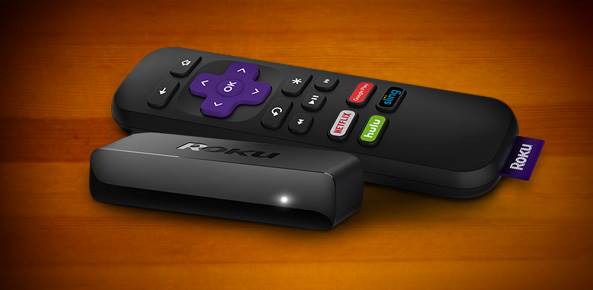
No matter who you are, if you’re looking for a way to stream video from the internet to your living room TV, Roku hopes to have you covered.
The Saratoga company, long known for offering affordable, easy-to-use digital media players, recently revamped its lineup. I’ve been testing out the two ends of Roku’s range — the bargain-priced Express and the top-of-the-line, $130 Ultra — to get a sense of what you’ll experience with the company’s latest gadgets. I came away particularly impressed with the Express.
The Express [pictured above, front] is not only the least expensive box Roku has ever offered, it’s also the lowest priced digital streamer among all the major competitors, even lower than Google’s original Chromecast. But don’t let the Express price fool you — it offers many of the same features that you’ll find on the higher-priced Ultra.
Both boxes give you access to some 3,500 digital channels and counting, which compares favorably with just about every other comparable digital streamer. That number includes nearly all of the major streaming and download video services, many sports channels, the major news and cable networks and lots of more obscure stuff.
Better yet, the picture quality it delivers is generally very good. In fact, even when viewing them up close, I often had a hard time telling the difference between high-definition videos streamed through the Express to an older 46-inch HD TV and 4K videos streamed through the Ultra to a similarly sized late-model 4K TV.
The Express also works much the same way as other Roku boxes, including the Ultra. It has the same universal search feature that allows you to look for movies, TV shows or actors across multiple channels at the same time. At last count, Roku’s search feature delves for content across more than 100 different channels, which is more than any other digital streaming box, according to the company.
The remote control Roku ships with the Express is more basic than the ones that come with its higher priced boxes. But the box itself supports many of the same functions if you use Roku’s app instead of the Express’ remote control.
For example, the remotes that come with the Ultra and Roku’s $100 Premiere+ include a headphone jack, which allows you to listen to your shows via earphones, so you don’t disturb others in your house. But you can do the same thing with the Express by using Roku’s app and plugging in your earphones to your phone. Likewise, the Ultra has a voice search feature that you can activate by pressing a dedicated button on its remote. But the Express has a voice search feature too; you just have to access it via a virtual button in the smartphone app.
Another cool thing about the Express is that Roku is selling it as a complete kit. You not only get the box, but an HDMI cable to connect it to your TV — something that doesn’t come with the pricier Ultra.
Roku did take some shortcuts with the Express to get the price down, beyond offering a less sophisticated remote. It has a slower processor than the Ultra, although I didn’t notice much of a difference in its performance. Unlike the Ultra, the Express doesn’t support 4K or high dynamic range (HDR) video, so if you have one of the latest televisions with the most advanced technology on it and want a box that will take advantage of those features, this isn’t it.
For me, its biggest shortcoming was that the only way you can connect it to the internet is the older 2.4 GHz WiFi standard, which tends to have a lot of interference. When I was testing the Express, it took significantly longer than the Ultra to download channels and sometimes initially displayed videos in relatively low resolutions, even though I have a fast broadband connection and a WiFi router that was within a couple feet of the device. In some cases, the Express even got stuck trying to buffer the video and never started playing it; I had to back out and try to load up a different one. However, when the videos did play — which was most of the time — their resolution tended to improve the longer I watched.
On the other end of the spectrum from the Express is Roku’s Ultra. The company debuted its first 4K box last year. Now it has three different ones to choose from; the Ultra is Roku’s flagship model, which supports both 4K and HDR, a technology that promises to greatly improve picture quality by offering a much broader contrast range. 4K is becoming ubiquitous on larger-screen TVs, while HDR is starting to make its way into mainstream models.
As popular as 4K is becoming, it still suffers from the same problems that it has had in the past. On average sized sets seen at normal viewing distances, it’s basically impossible to tell the difference between 4K and HD images. Meanwhile, there’s still only a limited amount of video that you can view in 4K.
Of all the channels offered through Roku’s boxes, only 15 can stream videos or display images in 4K, and that includes channels like Picasa, a photo sharing service, that are more like apps. HDR is likely to be more noticeable, but right now only three Roku channels — Netflix, Amazon and Fandango Now — offer any HDR videos, and then only a handful.
The Ultra offers more than just 4K and HDR support. Unlike the Express, the Ultra has a USB port, which allows you to watch videos or view pictures you’ve saved to external drives. It also includes both an Ethernet port and a dual-band WiFi radio. Connected to my router via Ethernet, the Ultra downloaded apps much quicker than the Express, often started videos faster as well and didn’t suffer from the same buffering problems.
Additionally, the Ultra includes a remote with a headphone jack, voice search feature and game buttons; a button on the box that will sound an alarm on the remote to help you find it; and an optical audio port to connect it to soundbars or high-end sound systems. But few of those features may matter much to you. Roku offers few games in its store. And in many cases you can use HDMI to transmit high-quality sound rather than an optical cable.
Don’t get me wrong. The Ultra is a very good device. But I’d recommend getting Roku’s Premiere or Premiere+ instead, because they offer many of the same features, including support for 4K, at a lower price than the Ultra.
And if you haven’t succumbed to the 4K hype and just want an affordable streamer, the Express is hard to beat.
© 2016 San Jose Mercury News under contract with NewsEdge. -.





![[CES 2026] Quest For Perfect Color…Samsung To Push](https://loginby.com/itnews/wp-content/uploads/2025/12/CES-2026-Quest-For-Perfect-Color…Samsung-To-Push-100x75.jpg)

